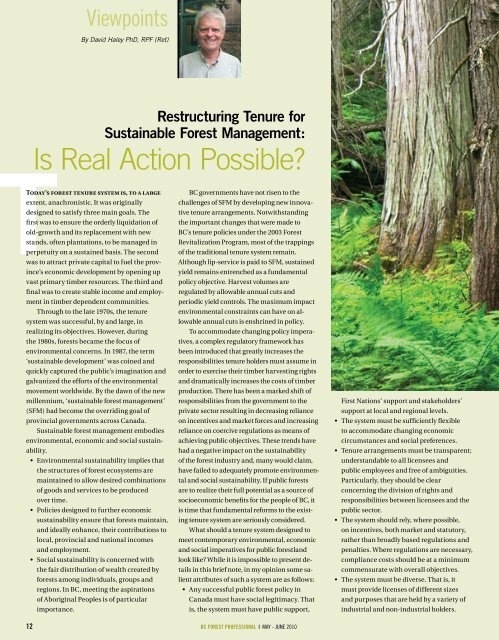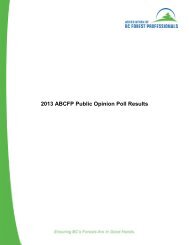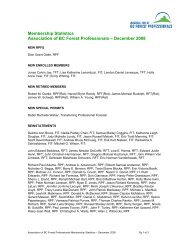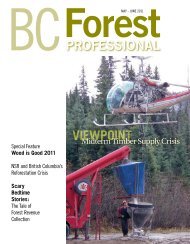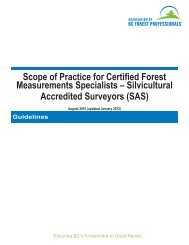VIEWPOINT - Association of BC Forest Professionals
VIEWPOINT - Association of BC Forest Professionals
VIEWPOINT - Association of BC Forest Professionals
You also want an ePaper? Increase the reach of your titles
YUMPU automatically turns print PDFs into web optimized ePapers that Google loves.
Viewpoints<br />
By David Haley PhD, RPF (Ret)<br />
Restructuring Tenure for<br />
Sustainable <strong>Forest</strong> Management:<br />
Is Real Action Possible?<br />
Today’s forest tenure system is, to a large<br />
extent, anachronistic. It was originally<br />
designed to satisfy three main goals. The<br />
first was to ensure the orderly liquidation <strong>of</strong><br />
old-growth and its replacement with new<br />
stands, <strong>of</strong>ten plantations, to be managed in<br />
perpetuity on a sustained basis. The second<br />
was to attract private capital to fuel the province’s<br />
economic development by opening up<br />
vast primary timber resources. The third and<br />
final was to create stable income and employment<br />
in timber dependent communities.<br />
Through to the late 1970s, the tenure<br />
system was successful, by and large, in<br />
realizing its objectives. However, during<br />
the 1980s, forests became the focus <strong>of</strong><br />
environmental concerns. In 1987, the term<br />
‘sustainable development’ was coined and<br />
quickly captured the public’s imagination and<br />
galvanized the efforts <strong>of</strong> the environmental<br />
movement worldwide. By the dawn <strong>of</strong> the new<br />
millennium, ‘sustainable forest management’<br />
(SFM) had become the overriding goal <strong>of</strong><br />
provincial governments across Canada.<br />
Sustainable forest management embodies<br />
environmental, economic and social sustainability.<br />
• Environmental sustainability implies that<br />
the structures <strong>of</strong> forest ecosystems are<br />
maintained to allow desired combinations<br />
<strong>of</strong> goods and services to be produced<br />
over time.<br />
• Policies designed to further economic<br />
sustainability ensure that forests maintain,<br />
and ideally enhance, their contributions to<br />
local, provincial and national incomes<br />
and employment.<br />
• Social sustainability is concerned with<br />
the fair distribution <strong>of</strong> wealth created by<br />
forests among individuals, groups and<br />
regions. In <strong>BC</strong>, meeting the aspirations<br />
<strong>of</strong> Aboriginal Peoples is <strong>of</strong> particular<br />
importance.<br />
<strong>BC</strong> governments have not risen to the<br />
challenges <strong>of</strong> SFM by developing new innovative<br />
tenure arrangements. Notwithstanding<br />
the important changes that were made to<br />
<strong>BC</strong>’s tenure policies under the 2003 <strong>Forest</strong><br />
Revitalization Program, most <strong>of</strong> the trappings<br />
<strong>of</strong> the traditional tenure system remain.<br />
Although lip-service is paid to SFM, sustained<br />
yield remains entrenched as a fundamental<br />
policy objective. Harvest volumes are<br />
regulated by allowable annual cuts and<br />
periodic yield controls. The maximum impact<br />
environmental constraints can have on allowable<br />
annual cuts is enshrined in policy.<br />
To accommodate changing policy imperatives,<br />
a complex regulatory framework has<br />
been introduced that greatly increases the<br />
responsibilities tenure holders must assume in<br />
order to exercise their timber harvesting rights<br />
and dramatically increases the costs <strong>of</strong> timber<br />
production. There has been a marked shift <strong>of</strong><br />
responsibilities from the government to the<br />
private sector resulting in decreasing reliance<br />
on incentives and market forces and increasing<br />
reliance on coercive regulations as means <strong>of</strong><br />
achieving public objectives. These trends have<br />
had a negative impact on the sustainability<br />
<strong>of</strong> the forest industry and, many would claim,<br />
have failed to adequately promote environmental<br />
and social sustainability. If public forests<br />
are to realize their full potential as a source <strong>of</strong><br />
socioeconomic benefits for the people <strong>of</strong> <strong>BC</strong>, it<br />
is time that fundamental reforms to the existing<br />
tenure system are seriously considered.<br />
What should a tenure system designed to<br />
meet contemporary environmental, economic<br />
and social imperatives for public forestland<br />
look like? While it is impossible to present details<br />
in this brief note, in my opinion some salient<br />
attributes <strong>of</strong> such a system are as follows:<br />
• Any successful public forest policy in<br />
Canada must have social legitimacy. That<br />
is, the system must have public support,<br />
12 <strong>BC</strong> FOREST PROFESSIONAL | may - june 2010<br />
First Nations’ support and stakeholders’<br />
support at local and regional levels.<br />
• The system must be sufficiently flexible<br />
to accommodate changing economic<br />
circumstances and social preferences.<br />
• Tenure arrangements must be transparent;<br />
understandable to all licensees and<br />
public employees and free <strong>of</strong> ambiguities.<br />
Particularly, they should be clear<br />
concerning the division <strong>of</strong> rights and<br />
responsibilities between licensees and the<br />
public sector.<br />
• The system should rely, where possible,<br />
on incentives, both market and statutory,<br />
rather than broadly based regulations and<br />
penalties. Where regulations are necessary,<br />
compliance costs should be at a minimum<br />
commensurate with overall objectives.<br />
• The system must be diverse. That is, it<br />
must provide licenses <strong>of</strong> different sizes<br />
and purposes that are held by a variety <strong>of</strong><br />
industrial and non-industrial holders.


